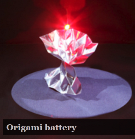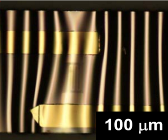|
Deformable Electronics |

|
Home | Contact Us | Research | Publications | People |



|
(Left) Stretchable temperature sensor on PDMS, (middle) Flexible and origami shear stress sensors on catheter, (right) origami lithium-ion battery.
Flexible, foldable and/or stretchable electronics is emerging as an attractive and promising new industry with great market potential in biomedical, personal care and wearable consumer electronics. Neuron probes, Fitbit wristband and flexible OLED display are the typical examples of them. Traditionally, the deformability is achieved by building devices on top of deformable substrates. For example, researchers at ASU have invented a low-temperature manufacture technology to build silicon transistors on top of flexible Polyethylene terephthalate (PET) substrate for OLED display for its flexibility. Another example is that Dr. Rogers at UIUC transfers thin silicon devices onto elastomers Polydimethylsiloxane (PDMS) to realize the strechability. With similar methods, we have developed various flexible and stretchable sensors. One example is flexible thermal flow sensors (with size of several hundred microns) on catheter for cardiovascular shear stress measurement based on this technology using Parylene. In-vivo experiments on shear stress sensors have been conducted with Newzeland White Rabbits, which verifies this micro instrument’s potential for biomedical diagnosis application. Similar functional devices with strethchability has also demonstrated by integrating microfabrication and elastomer substrate. However, flexible and stretchable substrates are usually made of organic materials, which provide a vehicle for the deformable electronics, but also become a limiting factor for their functions and performance. For high performance and full functions, devices and circuits require high temperature silicon fabrication processes, some of which are performed at high temperature around 1000oC, but organic materials can only sustain the temperature up to ~400oC. For example, the above mentioned low temperature silicon transistor process, which is developed for flexible OLED, has limited display’s refreshing rate. Consequently, there is a demand on the technology of producing flexible and stretchable platform incorporating standard high performance manufacture processes. Therefore, we have developed an origami enabled manufacture technology to conquer the challenges. Origami, traditional art of paper folding, has been applied to some engineering applications (e.g. stents and airbags) based on its principle of creating 3D structures from two-dimensional (2D) sheets through a high degree of folding along the creases. Our origami enabled manufacture technology in fact provides a universal solution for system-level of deformability. We employ one specific origami concept—rigid origami as our platform. Rigid origami is a type of origami which uses rigid island sheets joined by hinges. In our technology, we fabricate high performance devices and circuits onto island regions with standard manufacture processes and produce hinge-type crease structures between islands. Origami lithium-ion battery and solar panel are the two demonstrations on the concept. The key is then to produce reliable creases with the capability of repeatedly folding and unfolding, which provides rigid origami a system-level of deformability. With this purpose in mind, we have performed integration of conventional silicon-based fabrication with soft materials (e.g. polymer and gel) and manufacture technologies (e.g. 3D printing and laser dynamic forming). For example, phase change materials have been employed for hinge driving and locking, and combining silicon high performance devices with laser dynamic forming for 3D manufacture.
· Z. Song, T. Ma, R. Tang, Q. Cheng, X. Wang, D. Krishnaraju, R. Panat, C. K. Chan, H. Yu, and H.Jiang, “Origami Lithium-ion Batteries” Nature Communications, Volume: 5 Article Number: 3140 Published: JAN 2014 (pdf) · R. Tang, H. Tu, Y. Xu, H. Jiang and H. Yu, “ Micro Origami Solar Panel” Applied Physics Letters, Volume: 104 Issue: 8 Article Number: 083501 Published: FEB 24 2014 (pdf) · H Gao, R Tang, T Ma, H Jiang, H Yu, GJ Cheng, 2014, “Laser Shock Induced Conformal Transferring of Functional Devices on 3D Stretchable Substrates”, IEEE/ASME Journal of Microelectromechanical Systems, DOI: 10.1109/JMEMS.2014.2332512 (pdf) · H. Tu, H. Jiang, H. Yu and Y. Xu, “Hybrid silicon-polymer platform for self-locking and self-deploying origami” Applied Physics Letters, Volume: 103 Issue: 24 Article Number: 241902 Published: DEC 9 2013 (pdf) · H. Gao, R. Tang, T. Ma, H. Jiang, H. Yu, and G. Cheng, “Direct Integration of Functional Structures on 3D Microscale Surfaces by Laser Dynamic Forming”, Journal of Microelectromechanical Systems, On-line first, Digital Object Identifier: 10.1109/ JMEMS.2013.2262602 (pdf) · T. Ma, Y. Wang. R. Tang, H. Yu, and H. Jiang "Pre-patterned ZnO Nanoribbons on Soft Substrates for Stretchable Energy Harvesting Applications" Journal of Applied Physics, 2013 Volume: 113 Issue: 20 Article number: 204503 DOI: 10.1063/1.4807320. (pdf) · R. Tang, H. Huang, J. Oiler, M. Liang and H. Yu, “Three Dimensional Flexible Thermal Sensor for Intravascular Flow Monitoring” IEEE sensors journal, 2013, Digital Object Identifier: 10.1109/JSEN.2013.2264623 (pdf) · E. Kim, H. Tu, C. Lv, H. Jiang, H. Yu, and Y. Xu, “A Robust Polymer Microcable Structure for Flexible Devices” Applied Physics Letters, 2013: 102(3) pp:1-4 Article Number: 033506 DOI: 10.1063/1.4788917 (pdf) · C. Yu, Z. Wang, H. Yu, and H. Jiang, “A Stretchable Temperature Sensor Based on Elastically Buckled Thin Film Devices on Elastomeric Substrates”, Applied Physics Letter, 2009: Vol.95, 141912 (pdf) · C. Yu, H. Gao, H. Yu, H. Jiang, and G. J. Cheng, “Laser Dynamic Forming of Functional Materials Laminated Composites on Patterned Three-dimensional Surfaces with Applications on Flexible Microelectromechanical System”, Applied Physics Letter, 2009: Vol. 95, 091108 (pdf) · H. Yu, L. Ai, M. Rouhanizadeh, D. Patel, E. Kim, and T. Hsiai, “Flexible Polymer Sensors for In Vivo Intravascular Shear Stress Analysis,” Journal of Microelectromechanical Systems, 2008. 17(5): p. 1178-1186 (PDF) |